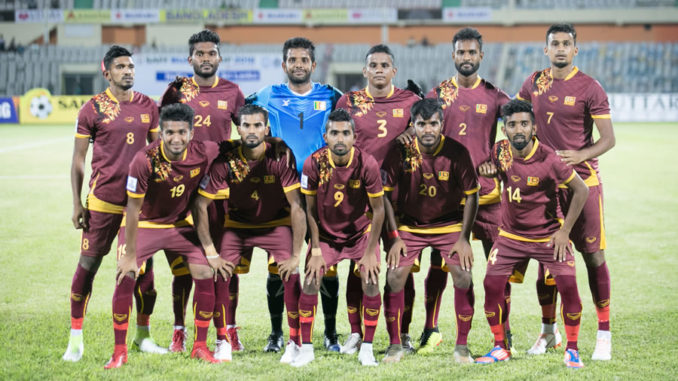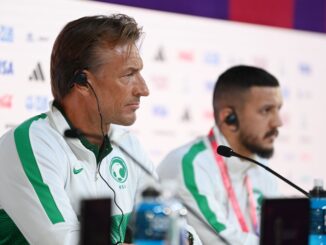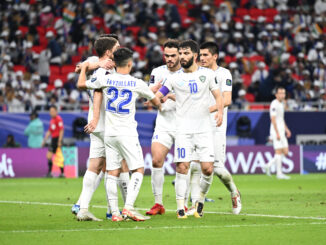
Five qualifiers in and one whole(-ish) round behind them, Sri Lanka are still sitting on a frustrating and unprecedented zero goals scored. How come, and do they have what it takes to eventually break through?
Just to be clear off the bat, the point of this piece is not to point fingers and laugh at Sri Lanka. They are the weakest team in the mix, and we all knew that from the very beginning, so what would be the point?
At the time of the draw in June, Sri Lanka was the only Asian side outside the Top 200 in the FIFA rankings still present for this round of the World Cup qualifying.
Four years ago, for reference, Bhutan was in the exact same position and they finished with a -47 goal differential. In the previous three World Cup qualifying cycles, meanwhile, Sri Lanka had only hung around for two games; now they are suddenly getting an extra eight.
What makes the Sri Lankan case unique is the fact they have not yet scored six games into the cycle. Not even in the preliminary playoff against their ‘peers’, something that was only allowed by the Macao fiasco.
Sri Lanka looked distinctly second best against Macao and progressed simply by the virtue of their opponent forfeiting the return leg. That might honestly be the only reason they are even here.
Again, for reference, Bhutan had already scored six times by the time November 2015 rolled in, putting three past Sri Lanka themselves in the first round and then participating in a 3-4 epic against the Maldives. Cambodia finished the second round with just a solitary goal scored, but they got rid of that ugly zero as soon as October.
Given the circumstances, there naturally isn’t a historic comparison to the current Sri Lankan struggles.
But could it really be that serious that Sri Lanka become the only side in history to go through two rounds of qualifiers without celebrating a single goal? I refuse to believe. And no one who’s ever sipped a Sri Lankan tea should wish it upon them. So let’s dig deep for some reasons for (mild) optimism.
Formation and mindset need to change
The cruel irony is that even on the last two occasions when they didn’t make it past the first round, Sri Lanka did find the back of the net. In 2015, it was a defender who’s no longer part of the national team setup, and in 2011, it was thanks to a midfielder who’s not suited up for them since September 2013.
Even counting 2018 SAFF Championship, Sri Lanka are still looking for their first competitive goal since the 2016 AFC Solidarity Cup. Landa Ishan is also the last attacker to do the job for Sri Lanka in a meaningful game with his strike against Macao exactly three years ago. Their last competitive goal against a side that’s taking part in this World Cup qualifying phase? Oh boy, that’d be Nepal at 2015 SAFF Championship; Sri Lanka’s most recent competitive win.
So yeah, the issue of getting the attack going has been a long-running one and much can be traced back to how Sri Lanka set up — in a negative 5-4-1 with a vastly isolated striker upfront.
These days, that striker is always very inexperienced which obviously isn’t helping the cause. Both Mohamed Aakib (19) and Dilip Peiris Kurukulasuriyage (22), the coach’s most trusted options up top, only debuted for Sri Lanka in 2019.
In this formation, very much designed to cede posession and invite pressure, both central midfielders are routinely overwhelmed. At the same time, one of the pair — Mohammadu Fasal — is routinely the only player capable of intricate passes. Or, at least, the only one willing to attempt them somewhat regularly.
Curiously enough, Sri Lanka by no means attempt the least passes of all teams in the second round. Maldives, Mongolia and Bangladesh all fall behind them on a per 90 minutes basis. Out of those who attempt marginally more passes, Nepal and Palestine are registering worse completion rates than Sri Lanka.
The actual trouble is, Sri Lanka are completing those passes incredibly deep on the field. North Korea, Malaysia, South Korea and Lebanon all recovered 17-24 balls high up the field, in the final third; an unhealthy trend.
At the same time, Sri Lanka don’t even register one touch in the box per 90; their passing just doesn’t reach that far. A side that’s so far produced a sole – one – chance that could be classified as a clear-cut (0.15 or more xG), and is only generating three shot attempts per game (in the second round), needs to change its approach.
With Sri Lanka, it’s not just about the gulf in quality, it’s also about the mindset they take into the games.
Playing quality is scarce
Then again, when volleyball is widely considered your country’s national sport and cricket enjoys by far the greatest attention (and has brought Sri Lanka the most success by even further), you might have a problem as a football coach. And it does show; over the five qualifiers, a mere 18 players have been used.
It’s therefore totally reasonable to ask whether Sri Lanka aren’t, in fact, already hitting their ceiling by, say, restricting North Korea to five shots on target to the tune of a mere 1.07 expected goals. That’s by all means a decent foundation, and when you have vastly limited tools, maybe it’s OK to not build on it?
Halfway through this round, after all, Sri Lanka are on pace to finish with 28 conceded goals; a total that’d rank above as many as four sides who didn’t see any of their eight games forfeited at this stage in 2015-16.
But here I am thinking: “If Bhutan could’ve done it — if Bhutan could’ve entertained — why not Sri Lanka?”
Maybe corner kicks could be the way to break out of the slump. They created four apiece against Lebanon and Malaysia, and one fifth of their shot opportunities (three out of 15) have come this way.
Maybe that could be the ‘Sri Lanka Way’, maybe that could be their face. Bhutan had the trickster in Chencho Gyeltshen, and that was kind of their selling card; Sri Lanka could use one too. Anything works at this point.
At the same time, it might be too late already.
With three trips ahead of them and the only remaining visitors being the mighty South Korea, one can easily imagine Sri Lanka going goalless down the stretch. Their best shot is arguably this week when they travel to Turkmenistan, who defeated North Korea 3-1 last week, while Sri Lanka had the bye last Thursday.
And so here I am, thinking once again: “If Guam did it against Turkmenistan in 2015, why not…”
All advanced stats courtesy of wyscout.com
Photo: SAFF Suzuki Cup
Listen to Sri Lankan international Zarwan Johar talk about football in Sri Lanka on Episode 27 of The Asian Game podcast




